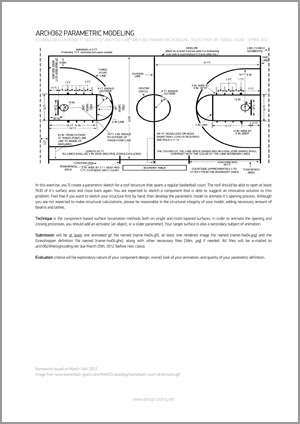Paramod 2011 Subdivided Entities
by Tuğrul Yazar | March 14, 2012 16:36
Today, we’ve studied fundamentals of component-based design methods. Using curves and surfaces as starting points, we’ve experienced ways of translating those entities via design criteria based on our purposes. First, a curve is used to construct a leaf structure. We’ve experienced dispatching data lists and combining them back together. Subdividing curves into points created further entities such as vectors and planes. We used those entities as inputs of regular drawing and modeling commands such as rectangles, or planar surfaces. This in-class exercise can be studied here. Second exercise was the standard parametric truss with a triangular component. Some of the cliche methods on surface subdivision is studied. Required files can be found at this post. This time, a quadrilateral surface is designed as a component and applied on a subdivided target suface.
Both exercises were examples of thinking back and forth, adapting into design purposes, not memorizing the ready-made definitions. Important part of this week was to understand the exploratory nature of parametric modeling in general. Foresight is usually crucial for us. This forces us to put our design purposes into real action world of geometry, and try to find best way to construct that by utilizing both induction and deduction. Then, experience becomes important because generally, design intentions are also formulated by our past studies. Finally, a hard working heart with an emotional commitment to design computing is required to be experienced and to have foresights. This week’s homework is the design of a moving roof structure. Let’s see what’ll happen.
 [1]
[1]- [Image]: https://www.designcoding.net/decoder/wp-content/uploads/2012/03/2012_03_14-362-hw04.pdf
Source URL: https://www.designcoding.net/week-05-subdivided-entities/